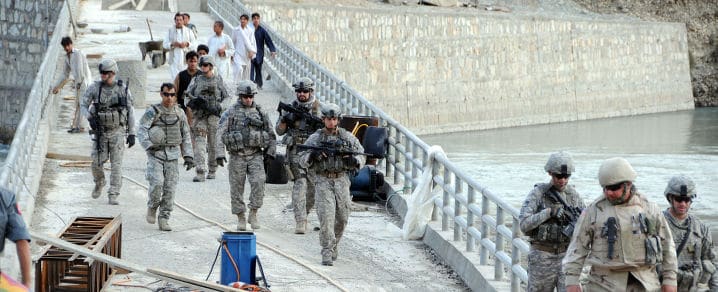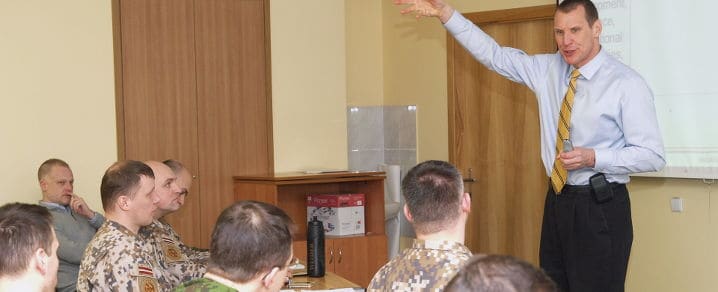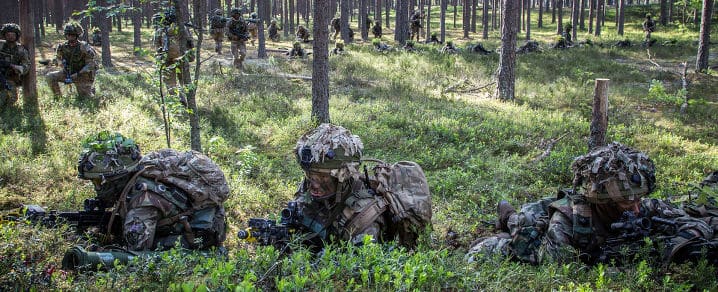“Interoperability is essential to ensure of NATO's forces effectiveness.”
Supreme Allied Commander Transformation, General Jean-Paul Paloméros, 25 Sept. 2013
Since the end of the Cold War, interoperability has been at the heart of a debate over the viability and relevance of the NATO Alliance in a new security environment. The shift of focus from territorial defense to multinational expeditionary missions (Afghanistan, Kosovo, Libya) and the challenges encountered executing them has demonstrated the limits of Allied interoperability. While some interoperability challenges (sovereignty concerns, differing national interests, cuts in defense spending, support for local defense industries, and disparities in technological capabilities) can only be resolved by politicians at the strategic level, there are also numerous tactical challenges to interoperability. They include technological disparities, command and control, doctrinal differences, and resource gaps. To mitigate them, NATO enacted the “Connected Forces Initiative” (CFI).
The goal of the CFI is to increase readiness and combat effectiveness by improving interoperability through expanded education and training, increased exercises, and better use of technology. To support the CFI, the Joint Multinational Training Command (JMTC) in Grafenwoehr, Germany, launched the “Combined Training Initiative” (CTI). Drawing on the JMTC’s unique location and experience educating and training NATO allies and multinational partners, the CTI expands education and training and uses technology to execute integrated, simultaneous, live, virtual, and constructive exercises. The CTI greatly reduces the cost of training, fosters multinational partnerships, and most importantly, improves Alliance interoperability.
The need
Recognizing this situation, Alliance leaders created the Connected Forces Initiative (CFI).
NATO defines interoperability “as the ability to operate in synergy in the execution of assigned tasks.” Even after many years of emphasizing interoperability and NATO Standard Agreements (STANAG) to foster it, recent missions have shown the limits of interoperability. Recognizing this situation, Alliance leaders created the Connected Forces Initiative (CFI). Its purpose is to ensure NATO formations can communicate, train, and operate together effectively. Although the need is clear, there are many challenges to implementing the CFI. The next section examines some of the main ones and how the Joint Multinational Training Command has mitigated them.
Challenges
While there are strategic and tactical challenges to interoperability, this paper focuses on the latter. This is because overcoming strategic challenges requires political decisions while overcoming them at the tactical level can be accomplished through the establishment of common tactics, techniques, and procedures (TTPs). Key tactical interoperability challenges include technological disparities, command and control, doctrinal differences, and resource gaps.
1. Technology disparities
There are vast technological disparities between NATO forces. On one end of the spectrum is the United States with its reliance on digital technology. Unmanned Aerial Systems (UAS), Command Post of the Future (CPOF), and Blue Force Tracker (BFT) are all readily available to an American commander and help him/her establish a common operational picture. However, this operational picture is not “common” if other members of a Joint Task Force can’t see it. There are at least 13 different systems for battle tracking within NATO. Many of them, because of different technical standards, are not interoperable.
To mitigate this situation, the JMTC has pursued low tech solutions.
To mitigate this situation, the JMTC has pursued low tech solutions. These include vehicle markings to identify friendly forces, using simple graphic control systems to control movement, reliance on FM radio communication, conducting rehearsals to achieve a shared understanding, and most effectively, ensuring every battalion or higher level formation has liaison officers (LNOs) to synchronize its operations with adjacent and higher level formations.
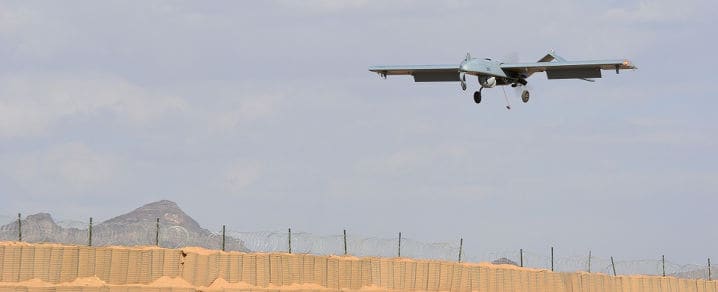
Shadow Unmanned Aerial System (UAS) inbound! The Shadow is a tactical Unmanned Aerial System (UAS) weighing about 400 lbs. with optical and infrared cameras effective over several miles. Pictured here, a Georgia Guard platoon brings in a system for landing. © Georgia National Guard
Exchanging LNOs is particularity effective as they facilitate integration and foster peer-to-peer contacts. This has both operational and long-term benefits. As MG Walter Piatt, the Deputy Commander of the US Army Europe noted: “countries don’t have relationships, people do. We gain credibility through shared hardship.”
2. Mission command and control
The past decade of war has reinforced the importance of integrated Command and Control. Operations have become very complex, distinguished by continuous interactions between friendly forces, enemy forces, and local populations. Simply giving national formations a “task and purpose” within a Joint Task Force is not enough. It requires collaborative planning and integration to develop and maintain a common understanding of the operational environment and the mission. Too often, units are deployed without knowledge of their allies’ systems or an understanding of what type of information is sent over to them. This lack of interoperability makes it difficult for units to communicate and maneuver effectively.
The JMTC mitigates this challenge by having its Observer, Coach and Trainer (OCT) Teams work with exercise participants before they arrive at the training center. The goal is to ensure all formations understand--and are able to integrate, each other’s unique capability and capacities. This includes having each participating country identify what types of equipment they use, how many networks they typically operate, and the type of information passed over them. This information leads to a construction of a compatibility matrix which shows what systems are able to communicate over different frequencies or networks.
3. Doctrinal differences
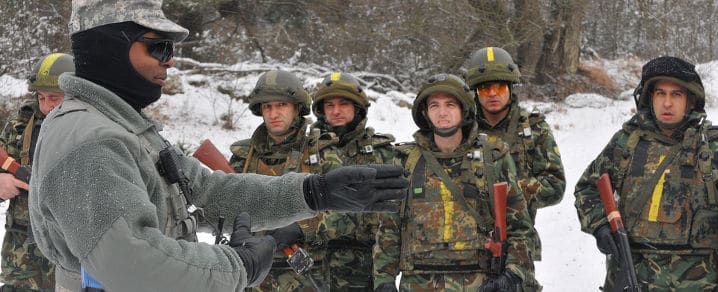
Sgt. 1st. Class Anthony Craft of U.S. Army Europe's Joint Multinational Readiness Center briefs Bulgarian soldiers on tactical movement procedures during a military advisory team training exercise at the JMRC in Hohenfels, Germany, Dec. 2. The MAT and police advisory team training programs are designed to replicate the Afghanistan operational environment while preparing teams for counterinsurgency and improvised explosive device operations and the ability to train, advise and enable Afghan security and police forces. Photo by Spc. Jordan Fuller
It’s not surprising that within a group of 28 countries there are significant doctrinal differences. For example in US doctrine, “Fires” means “integrating and delivering lethal and non-lethal fires to enable joint and maneuver commanders to dominate their operational environment." In contrast, NATO countries trained with Soviet doctrine employ Fires primarily in an area/barrage role. Also in contrast to US doctrine, these countries establish a "Hide" (a location approximately one kilometer from their designated Firing Point) to protect their artillery assets. This means Fires are not available for 15-25 minutes once they are called. Since US artillery assets are able to provide support in 3-5 minutes, this has a significant effect on interoperability.
To diminish doctrinal differences between countries, the JMTC has learned to make diversity a virtue. It doesn’t force Allies or multinational partners to use US Doctrine; instead it fosters functional interoperability. As an illustration, during a 2014 exercise, the 173 IBCT(A) had a Czech 152mm artillery battery attached to it. In accordance with Czech doctrine, the battery employed concealment and movement. This caused a lag between the call for fires and their delivery. To account for this difference, the 173 IBCT (A) established event based time triggers. Once the triggers were included in the planning process, the BCT was able to successfully execute timely and accurate joint fires. Noteworthy, because of the Czech emphasis on concealment, the BCT’s artillery assets were much less vulnerable to enemy attacks. This emphasis on functional interoperability improves Alliance capability and capacity.
4. Resource gaps
Sustaining multinational forces is a significant interoperability challenge. While a NATO Standard Agreement (STANAG) defines logistics as the planning and implementing force movement and maintenance; implementation of this standard varies. As in other areas, interoperability is affected by different terminology, traditions, capabilities, capacities, etc. Differences range from how many spare parts are carried to the type of rations soldiers eat. While many countries were able to access the US supply system in Afghanistan, expeditionary deployments to the JMTC have shown that some Alliance members have difficulty providing their own ammunition, food, and fuel; let alone taking care of sanitary needs, housing, water, etc.
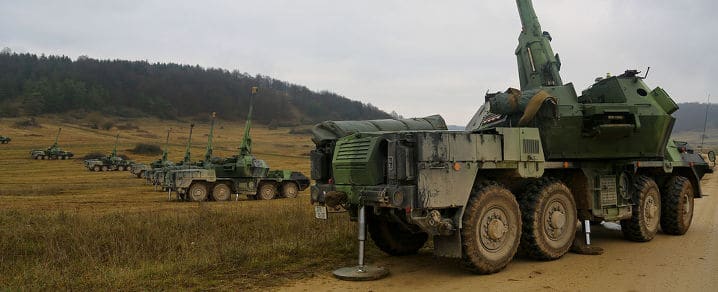
Czech Republic Army soldiers from 1st and 2nd Platoon Field Artillery maneuver a self-propelled gun-howitzer vehicle, called a DANA 152mm, into firing position while conducting simulated fire training during Combined Resolve at the Hohenfels training area at Hohenfels, Germany, Nov. 15, 2013. The exercise trains U.S. Soldiers, and multi-national brigades to defeat complex threats during coalition missions. Since the Joint Multinational Training Command’s Grafenwoehr and Hohenfels training areas are centrally located in Europe, U.S. forces, Army, Air Force, Navy, and Marine develop unique bonds with NATO, allied and multinational forces of 38 European nations. © U.S. Army photo by Spc. Derek Hamilton/Released
To foster interoperability, the JMTC attempts to implement the NATO principle of providing logistical support on a functional, rather than a national basis. Tactically, this can be accomplished through early pre-mission planning discussions between logisticians in a multinational working group. This group identifies capabilities and requirements to mitigate possible sustainment shortfalls. For example in a recent exercise, this working group identified a bulk water shortfall across the Joint Task Force. This challenge was solved by distributing water equally across the formation to ensure operations would continue unimpeded.
Although the interoperability challenges are significant, as a result of its location in the center of Europe, its unique capabilities, and its extensive experience working with Allied and multinational partner military forces over the last decade; the JMTC has been able to reduce them and provide effective, integrated training. However, it is still not at the level envisioned in NATO’s Connected Forces Initiative. To implement this guidance, the JMTC launched the Combined Training Initiative.
The Combined Training Initiative (CTI)
The CTI takes advantage of changing conditions to take NATO interoperability and operational readiness to a higher level. It is based on NATO’s three components of interoperability: technical, procedural, and human.
Technology
While joint planning and execution of exercises has been common throughout NATO for years, the JMTC has significantly improved interoperability through enhanced technology. For example, the JMTC’s Joint Multinational Simulations Center (JMSC - located at Grafenwoehr, Germany) establishes a Joint Operations Center to control and “fight” a distributed portion of exercise while the JMRC executes the live portion of the exercise. In Exercise Saber Junction 13, the 2nd Stryker Calvary Regiment conducted live training at the Joint Multinational Readiness Center while the Italian Folgore Brigade virtually supported its flank from Italy.
Noteworthy, both live and virtual units can be connected “up” to a NATO Corps Headquarters (the JMTC and the Allied Rapid Reaction Corps were connected for the first time in a Fall 2014 exercise); and “down” to subordinate brigades, battalions, and companies in Hohenfels and at Allied and partner training centers throughout Europe.
Noteworthy, both live and virtual units can be connected “up” to a NATO Corps Headquarters (the JMTC and the Allied Rapid Reaction Corps were connected for the first time in a Fall 2014 exercise); and “down” to subordinate brigades, battalions, and companies in Hohenfels and at Allied and partner training centers throughout Europe. The JMTC’s Combined Training Initiative fosters interoperability by integrating NATO and partner assets, capabilities, relationships, and technology to create live, virtual, and constructive exercises which simultaneously connect formations from the tactical to corps level across the continent. The CTI is the first time the JMTC—or any other combat training center, has executed exercises of this complexity and scale. This program allows Allies and multinational partners to train together while remaining in their home-station locations. This reduces costs while facilitating interoperability. As an illustration, exercise Swift Response II (August 2015), will be executed simultaneously at three different training centers in Bulgaria, Germany, and Romania.
Procedural
This category fosters interoperability through doctrinal and organizational changes. The Joint Multinational Readiness Center (a component of the JMTC– located at Hohenfels, Germany), is contributing to NATO Doctrine and developing STANAGs based on lessons learned at the Center. In addition, the JMRC is identifying and codifying tactics, techniques, and procedures (TTPs) which mitigate doctrinal diversity by focusing on functional interoperability. These TTPs are disseminated via the NATO Centers of Excellence (COE) and training facilities throughout Europe and North America.
Human
This group includes education, training, and the adoption of common terminology. Seeing rotational units struggle with interoperability challenges, the JMTC initiated the Joint Common Academic Program (JCAP). It has two components. The first is the deployment of mobile training teams (MTTs) to Allies and multinational partners to conduct leader training programs, provide specialty training, facilitate the development of local training centers, and participate in military-to-military cooperation events. Not only has this been a cost effective way to facilitate standardized education and training, but these missions also mean that when NATO formations train together, they start at a higher level of interoperability and readiness.
The second JCAP component is a series of instruction modules which are given to the staffs of all members of the Joint Task Force prior to an exercise. The seminars cover mission command, movement and maneuver, protection, logistics, fires, engagement, and intelligence; i.e. the key areas most affected by limited interoperability. During these seminars, leaders from the JMRC introduce key topics and identify challenges faced by previous units. The Joint Task Force then works with its subordinate formations to identify ways to mitigate the interoperability challenges.
Conclusion
As former U.S. Secretary of Defense Chuck Hagel noted “the most persistent and pressing security challenges to Europe and the United States are global.” Therefore we must “develop strategies to address global threats as we build more joint capacity with European militaries.” Because of its capabilities, location, and extensive experience working with NATO and partner countries, the JMTC is uniquely positioned to implement NATO training guidance. Its Combined Training Initiative improves NATO interoperability and readiness through expanded education and training and technology. This allows NATO members to work more effectively together and fosters European security by helping protect Alliance members, deterring conflict, and increasing global stability.

